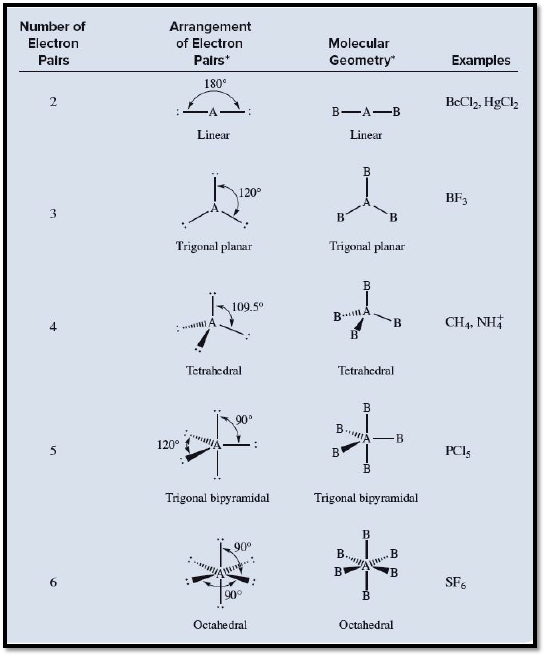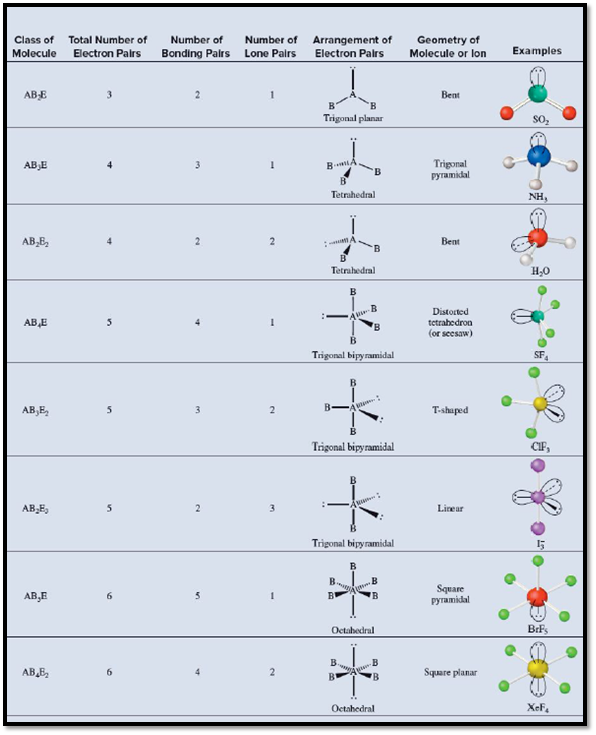
Concept explainers
(a)
Interpretation: The geometry of
Concept Introduction:
VSEPR means valence shell electron pair repulsion theory. This theory is the study of molecular geometry of molecules based on the electron pairs surrounding their central atoms.
The geometry of a given molecule can be predicted using the following steps:
Step1: The Lewis structure of the molecule has to be drawn
Step 2: The arrangement of electron pairs around the central atom, has to be determined.
Step 3: The arrangement of the bonding pairs has to be determined.
Step 4: Finally, the geometry of the molecule can be determined based on bonding pairs.
The following table shows the arrangement of electron pairs about a central atom (A) in a molecule and geometry of some simple molecules and ions in which the central atom has no lone pairs.

Figure 1
The following table shows the geometry of the molecules and ions in which the central atom has one or more lone pairs.

Figure 2
(b)
Interpretation: The geometry of
Concept Introduction:
VSEPR means valence shell electron pair repulsion theory. This theory is the study of molecular geometry of molecules based on the electron pairs surrounding their central atoms.
The geometry of a given molecule can be predicted using the following steps:
Step1: The Lewis structure of the molecule has to be drawn
Step 2: The arrangement of electron pairs around the central atom, has to be determined.
Step 3: The arrangement of the bonding pairs has to be determined.
Step 4: Finally, the geometry of the molecule can be determined based on bonding pairs.
The following table shows the arrangement of electron pairs about a central atom (A) in a molecule and geometry of some simple molecules and ions in which the central atom has no lone pairs.

Figure 1
The following table shows the geometry of the molecules and ions in which the central atom has one or more lone pairs.

Figure 2
(c)
Interpretation: The geometry of
Concept Introduction:
VSEPR means valence shell electron pair repulsion theory. This theory is the study of molecular geometry of molecules based on the electron pairs surrounding their central atoms.
The geometry of a given molecule can be predicted using the following steps:
Step1: The Lewis structure of the molecule has to be drawn
Step 2: The arrangement of electron pairs around the central atom, has to be determined.
Step 3: The arrangement of the bonding pairs has to be determined.
Step 4: Finally, the geometry of the molecule can be determined based on bonding pairs.
The following table shows the arrangement of electron pairs about a central atom (A) in a molecule and geometry of some simple molecules and ions in which the central atom has no lone pairs.

Figure 1
The following table shows the geometry of the molecules and ions in which the central atom has one or more lone pairs.

Figure 2
Want to see the full answer?
Check out a sample textbook solution
Chapter 10 Solutions
EBK GENERAL CHEMISTRY: THE ESSENTIAL CO
- Synthesis of Dibenzalacetone [References] Draw structures for the carbonyl electrophile and enolate nucleophile that react to give the enone below. Question 1 1 pt Question 2 1 pt Question 3 1 pt H Question 4 1 pt Question 5 1 pt Question 6 1 pt Question 7 1pt Question 8 1 pt Progress: 7/8 items Que Feb 24 at You do not have to consider stereochemistry. . Draw the enolate ion in its carbanion form. • Draw one structure per sketcher. Add additional sketchers using the drop-down menu in the bottom right corner. ⚫ Separate multiple reactants using the + sign from the drop-down menu. ? 4arrow_forwardShown below is the mechanism presented for the formation of biasplatin in reference 1 from the Background and Experiment document. The amounts used of each reactant are shown. Either draw or describe a better alternative to this mechanism. (Note that the first step represents two steps combined and the proton loss is not even shown; fixing these is not the desired improvement.) (Hints: The first step is correct, the second step is not; and the amount of the anhydride is in large excess to serve a purpose.)arrow_forwardHi I need help on the question provided in the image.arrow_forward
- Draw a reasonable mechanism for the following reaction:arrow_forwardDraw the mechanism for the following reaction: CH3 CH3 Et-OH Et Edit the reaction by drawing all steps in the appropriate boxes and connecting them with reaction arrows. Add charges where needed. Electron-flow arrows should start on the electron(s) of an atom or a bond and should end on an atom, bond, or location where a new bond should be created. H± EXP. L CONT. י Α [1] осн CH3 а CH3 :Ö Et H 0 N о S 0 Br Et-ÖH | P LL Farrow_forward20.00 mL of 0.150 M NaOH is titrated with 37.75 mL of HCl. What is the molarity of the HCl?arrow_forward
 ChemistryChemistryISBN:9781305957404Author:Steven S. Zumdahl, Susan A. Zumdahl, Donald J. DeCostePublisher:Cengage Learning
ChemistryChemistryISBN:9781305957404Author:Steven S. Zumdahl, Susan A. Zumdahl, Donald J. DeCostePublisher:Cengage Learning ChemistryChemistryISBN:9781259911156Author:Raymond Chang Dr., Jason Overby ProfessorPublisher:McGraw-Hill Education
ChemistryChemistryISBN:9781259911156Author:Raymond Chang Dr., Jason Overby ProfessorPublisher:McGraw-Hill Education Principles of Instrumental AnalysisChemistryISBN:9781305577213Author:Douglas A. Skoog, F. James Holler, Stanley R. CrouchPublisher:Cengage Learning
Principles of Instrumental AnalysisChemistryISBN:9781305577213Author:Douglas A. Skoog, F. James Holler, Stanley R. CrouchPublisher:Cengage Learning Organic ChemistryChemistryISBN:9780078021558Author:Janice Gorzynski Smith Dr.Publisher:McGraw-Hill Education
Organic ChemistryChemistryISBN:9780078021558Author:Janice Gorzynski Smith Dr.Publisher:McGraw-Hill Education Chemistry: Principles and ReactionsChemistryISBN:9781305079373Author:William L. Masterton, Cecile N. HurleyPublisher:Cengage Learning
Chemistry: Principles and ReactionsChemistryISBN:9781305079373Author:William L. Masterton, Cecile N. HurleyPublisher:Cengage Learning Elementary Principles of Chemical Processes, Bind...ChemistryISBN:9781118431221Author:Richard M. Felder, Ronald W. Rousseau, Lisa G. BullardPublisher:WILEY
Elementary Principles of Chemical Processes, Bind...ChemistryISBN:9781118431221Author:Richard M. Felder, Ronald W. Rousseau, Lisa G. BullardPublisher:WILEY





